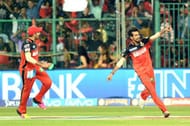Rewind to the 1970's – A time when all whites and cigarettes were the norms at a cricket match. When precedence was given to the finer nuances of the game and sportsmanship over inventiveness and glory. When money meant "barely" a couple of hundred dollars a week, in came a certain Mr. Kerry Packer with his brand of "pyjama cricket" and the gentleman's game was never to be the same again.
A business and media tycoon from Australia, Packer sought to increase his Nine Network’s stake in Australian sports and media by bidding for the cricket rights in the country. After being rebutted by the Australian Cricket Board (ACB), not one to give up, Packer decided to bring forward an ambitious project involving Australian players against a World XI which included some of the greats of the time like Sir Vivian Richards, Tony Greig, Imran Khan and the cream of the isolated South African side.
With brilliant camera work, a trademark of Channel Nine to this day, World Series Cricket (WSC) was born in 1977. More than the “We give a damn to the ACB” attitude of Packer and his players, it was the money that set alarm bells ringing. Cricket players were appallingly paid and in Packer’s own words, it was, “the easiest sport in the world to take over ... nobody bothered to pay the players what they were worth".
Although it was not a success, with paltry attendances and bans on participating players by their respective boards, the WSC was something of a pioneer for today’s plethora of cricketing leagues and the best of them all, the Indian Premier League (IPL).
The start
In 2007, Zee Entertainment Enterprises had just launched its own sports channel and in order to produce quality sports content, they launched the Indian Cricket League (ICL). They signed international players but mainly tapped into the Indian talent pool, which included many budding but ignored cricketers. With the ICL enjoying decent success and of course raking in the ‘moolah’, a backlash was to be expected from the apex body and it came down as a hammer blow onto the rebel league.
The BCCI, as well as the ICC, refused to recognize the league and served show-cause notices to all those associated with it. As a result, cricketing boards around the world banned the participating players and the ICL had to be called off.
But somewhere, a seed had been sown. In 1995, Lalit Modi had made a rough draft of a cricket league and had registered his company called the Indian Cricket League Limited. While it never took off then, the BCCI, in an effort to completely disintegrate the ICL, knew whom to look to. Being a member of the BCCI helped Modi to a great extent as he had his men in all the right places.
Combining his earlier registration and using the ICL as a base, in September 2007, Modi announced the Indian Premier League. In a format similar to football leagues world over, with national and international players playing in the same team coupled with the financial beef of the BCCI, it set tongues wagging. Lalit Modi had struck oil.
Money speaks
The million dollar question was what would be the teams and who would play for whom? The BCCI invited bids for the teams from companies for a period of ten years. The latter would pay a franchise fee, player salaries and state association fees and in return would receive broadcasting rights, ticket shares and a huge bulk of sponsorships.
The first season of the IPL had 8 teams, Mumbai Indians, Royal Challengers Bangalore, Chennai Super Kings, Deccan Chargers, Kolkata Knight Riders, Delhi Daredevils, Kings XI Punjab and Rajasthan Royals. Players were auctioned for a total amount of over $5 million dollars with an almost equal distribution over the 8 teams.
Most sportspersons have the best phase of their sporting lives before they hit the “grand old” age of 30. Post that dreaded number, while some age gracefully, others hit a sudden slump and never recover to be good enough for their respective national sides again. The IPL has changed all of that.
Players nearing or even post international retirement were now given a chance to showcase their skills in an equally competitive but less pressure atmosphere. Many players, for this reason, have called for an IPL window, chiefly Daniel Vettori. Here’s what the RCB coach had to say in an interview; “We hope that that window is cleared out because the guys enjoy playing here and there's financial security as well, which helps a lot.”
With players going under the hammer, transfers, huge sums of money being shelled out on individual stars and multi-million dollar sponsorship deals, cricket was never going to be the same again. The BCCI had unearthed a golden egg laying goose, the size of a T-rex.
Anything for entertainment
Yes exactly, in the IPL, entertainment is the numero uno factor when it comes to pulling in crowds and getting in the TRP’s. It has gone from being a “slam bam thank you ma’am” competition to a serious form of sports entertainment. The presence of Bollywood stars Shahrukh Khan and Preity Zinta as owners, cheerleaders on-field (and now also in the broadcast studio); entertainment and sports have amalgamated perfectly in the IPL.
While Australia’s Big Bash and South Africa’s Ram-Slam can claim to have similar tournaments, the ability to pull some of the biggest stars, on and off the field places the IPL at the summit of T-20 leagues.
The entertainment doesn’t end only with star names wearing snazzy frames. On field too, entertainment has taken an entirely new meaning. In the pre-IPL era, a couple of sixes, a jumping catch or a swinging yorker got crowds going. The IPL has revolutionized the game completely. Gone are the days when batsmen took a few overs to get set and then hit out.
Now, David Warner, Chris Gayle, Brendon McCullum and the likes get going from ball one, looking to send the white nut into oblivion. The kind of shots players play now range from textbook and classy (Virat Kohli) to innovative and outrageous (AB de Villiers). Batsmen have been forced out of their comfort zones and have responded brilliantly. Players like Steven Smith (Australia, Rising Pune Supergiants) have shown that the IPL can be used as a platform for getting international recognition too.
Similarly, bowlers also have been made to think. Already a batsman dominated game, cricket has become even tougher for bowlers now with batsmen becoming carefree and not holding back on attacking from the word go. Variations like the back of the hand slower deliveries, sudden changes in action or mastery of the yorker have become an essential part of a bowler’s repertoire of tricks. That is why a Mustafizur Rahman (Sunrisers Hyderabad) has been devastating in the shortest format and the IPL 2016, as compared to a Dale Steyn.
Strong performances in the IPL have helped players improve and thus have resulted in much better performances for their national side; A win-win situation for everyone.
Stepping stones for the future
A massive competition now, with virtually unlimited financial backing, the IPL has the potential to bring in changes to benefit the game as a whole. It could bring in some rule changes like uniform ground sizes, or an extra over to a particular bowler (5 in place of the current 4). Bowlers could benefit from being allowed an extra bouncer or fielders directly behind the bowler/wicket keeper. The possibilities are endless.
Ex-players and officials must use the IPL for more than increasing their bank balances. The IPL is a fertile land full of budding players and the right guidance to a couple of them even could take their careers a long way. Other leagues, spin-offs of the IPL, in Pakistan, West Indies and Bangladesh are doing their best to compete but it’s a David vs Goliath battle which Goliath has already won. Reminiscent of Hulk vs Loki, the IPL has smashed all competition with their financial might.
There is a great scope for cricket to go the football way with T-20 leagues dominating most of the year with international cricket restricted to World Championships. While that would mean the death of test cricket, it would open windows unknown.
The IPL has evolved greatly from being an idea in 1995 to becoming a cash cow and now it can become a potential game changer. What remains to be seen though is, will it?
Brand-new app in a brand-new avatar! Download Cric Rocket for fast cricket scores, rocket flicks, super notifications and much more!



